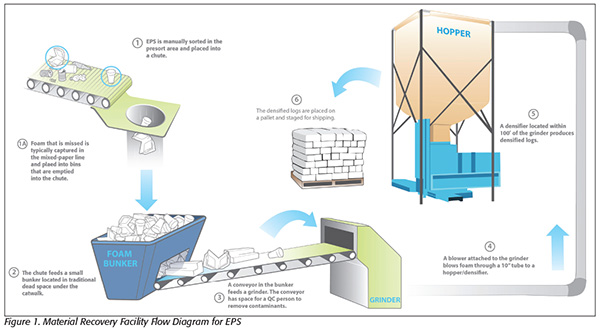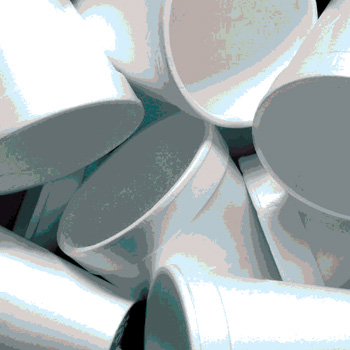While the idea of sustainability has moved past the novelty phase that felt like a buzzword trend a decade ago, the need to continue to look for meaningful ways to further reduce the constant stream of waste sent to landfills remains. The Foodservice Packaging Institute (FPI), a North American trade association composed of manufacturers, suppliers, distributors and operators/retailers in the foodservice and packaging industry, has launched a new initiative that takes an important step in ensuring valuable reusable materials are recycled instead of sent to landfills.
In 2014, a dozen members of the FPI came together to establish the Foam Recycling Coalition (FRC) to provide direct support for the increased recycling of foodservice packaging made from expanded polystyrene (EPS) foam. Foodservice industry items made of EPS foam include the cups, plates, bowls and carryout containers we’re all familiar with. However, when considering that items like meat packages and egg cartons from the grocery store are often made from the same polystyrene foam, it is just as important to recycle these materials as it is to recycle plastic bottles. With this in mind, in 2015, the FRC, in association with the EPS Industry Alliance, announced a new grant program to help businesses in the recycling industry increase their capacity to accept postconsumer EPS foam products.
Until recently, the bulk of EPS foam recycling efforts have focused on industrial sectors where things like protective packaging for refrigerators or televisions result in large volumes of material collected from commercial product distributors and vendors. The FRC grants will target supporting entities that manage residential curbside and drop-off recycling programs to extend foam product recycling to the individual consumer level.
“The idea behind the grant program is to help material recovery facilities recycle EPS cost-effectively,” remarks Lynn Dyer, president of the FPI. “Essentially, it’s all about volume and economics. What can we do to make diverting consumer-level EPS foam products from the waste stream more appealing to the recycling industry from an economic perspective?”
The obstacle, as Dyer points out, has always been the sheer volume of space required to transport the recycled foam content to a processor that will then recompose the foam into a reusable form for the next stage of a continued life cycle. The grant program specifically provides funding for material recovery facilities to purchase a specialized compactor known as a densifier that compresses the foam. Since foam products are more than 90 percent air, the densifier greatly reduces the volume of space required to store or transport EPS. As an example, a 48-foot truckload of baled EPS foam weighs approximately 16,000 pounds. After the foam is densified, the same truck can be packed with approximately 40,000 pounds of foam, greatly increasing the cost-effectiveness of collecting and redistributing EPS materials.
 By supporting postconsumer recycling at the material recovery facility level, the FRC expects to significantly increase the amount of EPS that is returned to the manufacturing process, ultimately getting reused to manufacture all kinds of products from surfboards to bike helmets (Figure 1). Currently, EPS foam manufacturers are generally recycling scrap foam in a closed-loop process, meaning the excess foam produced stays in the manufacturing facility and is recomposed with no waste. For those in the EPS industry, regardless of what their foam is manufactured into, increasing recycling opportunities and the public’s awareness of them is important.
By supporting postconsumer recycling at the material recovery facility level, the FRC expects to significantly increase the amount of EPS that is returned to the manufacturing process, ultimately getting reused to manufacture all kinds of products from surfboards to bike helmets (Figure 1). Currently, EPS foam manufacturers are generally recycling scrap foam in a closed-loop process, meaning the excess foam produced stays in the manufacturing facility and is recomposed with no waste. For those in the EPS industry, regardless of what their foam is manufactured into, increasing recycling opportunities and the public’s awareness of them is important.
“We’re very interested in helping to inform the public that these products can and should be recycled,” comments Todd Huempfner, vice president of operations with a foam technologies company. “Increasing the volume of reusable foam on the consumer level is good for the environment, good for the public and good for the many different industries that use new and recycled EPS foam for everything from commercial insulation for construction to protective packaging for wine, medicine and refrigerated foods.”
Dyer agrees and takes time to point out a few common misconceptions about recycling food packaging products. The first of which is that foam can’t be recycled at all, which is obviously not the case. The second relates directly to the foodservice industry, where many consumers are under the impression that polystyrene foam packaging used to hold food products is more contaminated than other forms of packaging.
“It’s a continual process with dual objectives of creating opportunities to expand EPS foam recycling opportunities on the individual level and then increase public awareness that those opportunities exist,” remarks Dyer.
When the FPI announced the grant program, Dyer’s office was inundated with applications from material recovery facilities across the United States and Canada. Her team applied very specific criteria in selecting the first grant recipient, including the company’s current level of innovation, its market reach within its community and its ability to process a combination of commercial, industrial and residential foam products. After an exhaustive review and evaluation, the FRC decided on a Denver-area company that has maintained a dedication to sustainable practices since the company’s inception in 1999.
“[Our company] has a reputation in this market as the innovators of the waste-and-recycling industry while maximizing sustainability and helping to preserve the environment,” remarks Brent Hildebrand, the company’s vice president of recycling. “The grant from the Foam Recycling Coalition affirms our place as leaders in the recycling community, and we’re very excited to promote this new efficiency in EPS foam recycling with the advanced technology in our expanded, retooled recycling plant.”
When asked what is on the horizon for the FRC and its efforts to support EPS foam recycling, Dyer suggests that the answer is hopefully more of the same. Additional grant applicants, more detailed investigations into each applicant’s reach and effectiveness, and more grant awards followed by a public information process to make consumers aware of the opportunity to recycle products that are every bit as common and reusable as those made of other materials are planned.
Sean O’Keefe of Layer Cake Creative is a built-environment communications professional with more than 15 years of experience writing for some of the Rocky Mountain region’s top design and construction firms. He can be reached at sean@golayercake.com.



